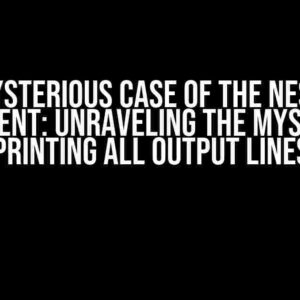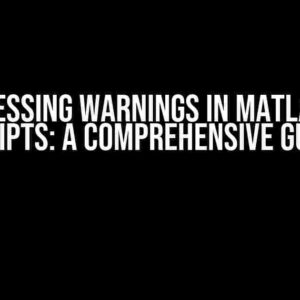GNU Make is an essential tool for any developer, allowing you to automate the build process and manage dependencies with ease. But what happens when you need to handle dependencies across multiple directories? Fear not, dear developer, for this article will take you on a journey to master GNU Makefile dependencies across three directories!
Understanding the Basics
Before diving into the nitty-gritty, let’s quickly cover the basics of GNU Make. A Makefile is a script that tells Make how to build your project. It consists of rules, each specifying a target (the file to be built) and its dependencies (the files required to build the target).
# Simple Makefile example
target: dependency1 dependency2
command to build target
The Problem: Dependencies Across Three Directories
Now, imagine you have three directories: src, lib, and include. Each directory contains files that depend on each other. For instance, a source file in src might include a header file from include, which in turn depends on a library file in lib. How do you manage these dependencies using a single Makefile?
The Solution: Using VPATH and vpath
The first step is to tell Make where to find the files in each directory. You can do this using the VPATH and vpath variables.
# Set VPATH to search for files in all three directories VPATH = src:lib:include # Set vpath to specify the directories for each type of file vpath %.c src vpath %.h include vpath %.a lib
Managing Dependencies
Now that Make knows where to find the files, it’s time to specify the dependencies between them. Let’s create a simple example:
# Dependencies between files
src/main.o: src/main.c include/header.h lib/libfile.a
$(CC) -c $< -o $@
include/header.h: lib/libfile.a
# No command needed, just specify the dependency
lib/libfile.a: lib/libfile.c
$(AR) rcs $@ $<
In this example, main.o depends on main.c, header.h, and libfile.a. The header.h file, in turn, depends on libfile.a. Finally, libfile.a is built from libfile.c.
Pattern Rules
To simplify the Makefile, you can use pattern rules to specify the build commands for each type of file. For example:
# Pattern rule for building object files
%.o: %.c
$(CC) -c $< -o $@
# Pattern rule for building archive files
%.a: %.o
$(AR) rcs $@ $<
These pattern rules will be applied automatically to any files that match the pattern. For instance, the first rule will be used to build main.o from main.c.
Advanced Topics
Order-Only Dependencies
Sometimes, you need to specify a dependency that should not trigger a rebuild of the target file. This is where order-only dependencies come in. You can use the | symbol to specify an order-only dependency:
src/main.o: src/main.c | include/header.h
$(CC) -c $< -o $@
In this example, main.o depends on header.h, but only as an order-only dependency. If header.h changes, main.o will not be rebuilt.
Recursive Make
What if you have a complex project with multiple subdirectories, each containing their own Makefile? You can use recursive Make to build each subdirectory separately:
# Recursive Make example
SUBDIRS = dir1 dir2 dir3
all: $(SUBDIRS)
$(SUBDIRS):
$(MAKE) -C $@
clean:
for d in $(SUBDIRS); do \
$(MAKE) -C $$d clean; \
done
In this example, the top-level Makefile will build each subdirectory in sequence, using the Makefile in each subdirectory to manage its dependencies.
Conclusion
Managing dependencies across multiple directories using GNU Make can be a challenging task, but with the right techniques, it becomes a straightforward process. By using VPATH, vpath, pattern rules, and advanced features like order-only dependencies and recursive Make, you can master the art of dependency management.
Remember, the key to success lies in understanding the dependencies between your files and specifying them correctly in your Makefile. With practice and patience, you'll be writing complex Makefiles like a pro!
Frequently Asked Question
Get ready to dive into the world of GNU Makefile dependencies across three directories!
Q1: How do I specify dependencies across three directories in a GNU Makefile?
You can specify dependencies across three directories by using the `-I` option followed by the directory path. For example, if you have directories `dir1`, `dir2`, and `dir3`, you can specify the dependencies as follows: `include dir1/Makefile dir2/Makefile dir3/Makefile`. This will allow Make to search for dependencies in all three directories.
Q2: What if I have a dependency in a subdirectory of one of the three directories?
No worries! You can still specify the dependency by using the `-I` option followed by the subdirectory path. For example, if you have a subdirectory `subdir` within `dir1`, you can specify the dependency as follows: `include dir1/subdir/Makefile`. Make will recursively search for dependencies in the subdirectory.
Q3: How do I avoid recursive dependencies when specifying dependencies across three directories?
To avoid recursive dependencies, you can use the `include` directive with the `-include` option. This will prevent Make from recursively including the same Makefile multiple times. For example: `-include dir1/Makefile dir2/Makefile dir3/Makefile`. This way, Make will only include each Makefile once, avoiding recursive dependencies.
Q4: Can I use wildcards to specify dependencies across three directories?
Yes, you can use wildcards to specify dependencies across three directories. For example, you can use the `wildcard` function to specify dependencies in all three directories: `include $(wildcard dir1/*) $(wildcard dir2/*) $(wildcard dir3/*)`. This will include all Makefiles in each directory and its subdirectories.
Q5: How do I troubleshoot dependencies across three directories if something goes wrong?
If something goes wrong, you can use the `--debug` option to troubleshoot dependencies. This will print debugging information, including the dependencies that Make is searching for. You can also use the `--print-directory` option to print the directory tree as Make searches for dependencies. This will help you identify any issues with your dependencies.






